|
Winmate C350T
Rugged compact PDA with legacy look and size, contemporary electronics and performance, OS choices, and industrial grade data collection options
(by Conrad H. Blickenstorfer with photography by Carol Cotton)
These days, almost all consumer smartphones pretty much look like the iPhone, and most ruggedized versions do, too. They are elegant, slender rectangles with capacitive touch screens that let users tap and pan and pinch. Almost all, but not all. The Winmate C350T still looks like Pocket PCs used to, with plastic housing, a 3.5-inch QVGA screen, a stylus, and a numeric keypad.
It's not like Winmate isn't paying attention to the latest phone fashion trends — they make sleek, super-modern multi-touch handhelds, too. It's just that they believe there's still room for a good-old-fashioned Pocket PC, one that's plenty tough, doesn't break easily, and has a real keypad with real individual keys. But, and here you can tell it's 2013 and not 2002, one that comes with Android as its default OS. But that's not he one they sent us. Our tester came with the also available Windows CE 6.0. We'll explain why later.
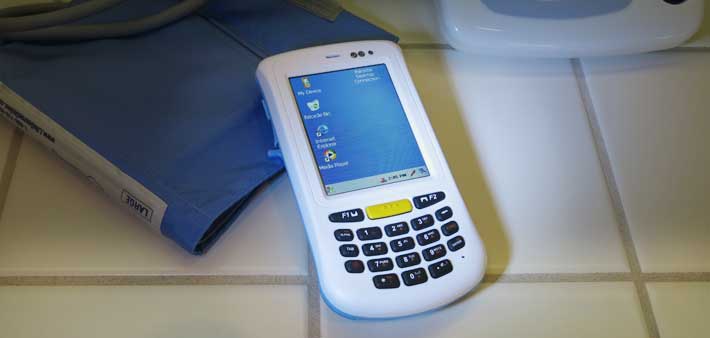
Compact, basic, budget-friendly and flexible
There's no denying that the C350 has a decidedly vintage look to it. There's a 3.5-inch transflective screen with a resistive digitizer that's best operated with the supplied stylus. The display is slightly recessed instead of flush-mounted as is the case with almost all modern procap smartphones. That's for better display protection, but it again emphasizes stylus rather than touch operation.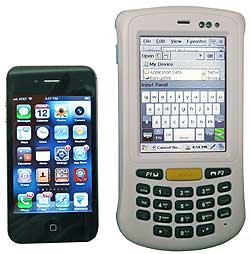
In terms of size, measuring 3.1 x 6.0 inches, being well over an inch thick, and weighing about ten ounces, the C350 recalls an era where your average Pocket PC and PDA were just about this big and heavy. The picture to the right shows how the Winmate C350 compares to an Apple iPhone 4s. That said, compared to other industrial, ruggedized handhelds and mobile terminals, the C350 is indeed, as Winmate calls it, a "compact-class PDA."
As far as tech specs go, Winmate's little workhorse is based on the Texas Instruments DM3730 processor running at 1GHz. This is an OMAP-compatible package with an ARM Cortex-A8 core and a powerful graphics accelerator. And the C350 also includes new-era tech such as a micro-SD card slot, speedy 802.11n WiFi, integrated GPS, an optional 5mp camera, and optional 3.5G mobile broadband. And that's on top of also available scanners and RFID.
What's interesting is that the C350 platform's default OS is Android, by far the leading OS in consumer smartphones. So why does Winmate also offer Windows CE and Windows Mobile? Because that still makes sense as most industrial and vertical market mobile handheld computer deployments are Microsoft based and running a mobile legacy OS comes in handy in numerous applications.
Winmate's positioning of the C350 seems to be that of an inexpensive tool for vertical market jobs with hardware that's legacy-friendly enough to fit into any existing infrastructure, flexible enough to allow whatever software is deemed optimal for an application, and technology advanced enough to fill contemporary expectations.
Design and construction
Compared to a modern smartphone, or even Winmate's own E430 and other of the company's modern-style multi-touch handhelds, the C350 looks decidedly traditional. Its body is made of plastic with just the smallest hint of rubberized bumper areas in the corners. There's the simple integrated physical keypad for rapid data entry, and with buttons large enough even for big fingers and with gloves on. While our review device came in the white/light-blue version targeted at healthcare markets, Winmate also offers the C350 in the more conventional and utilitarian dark gray.
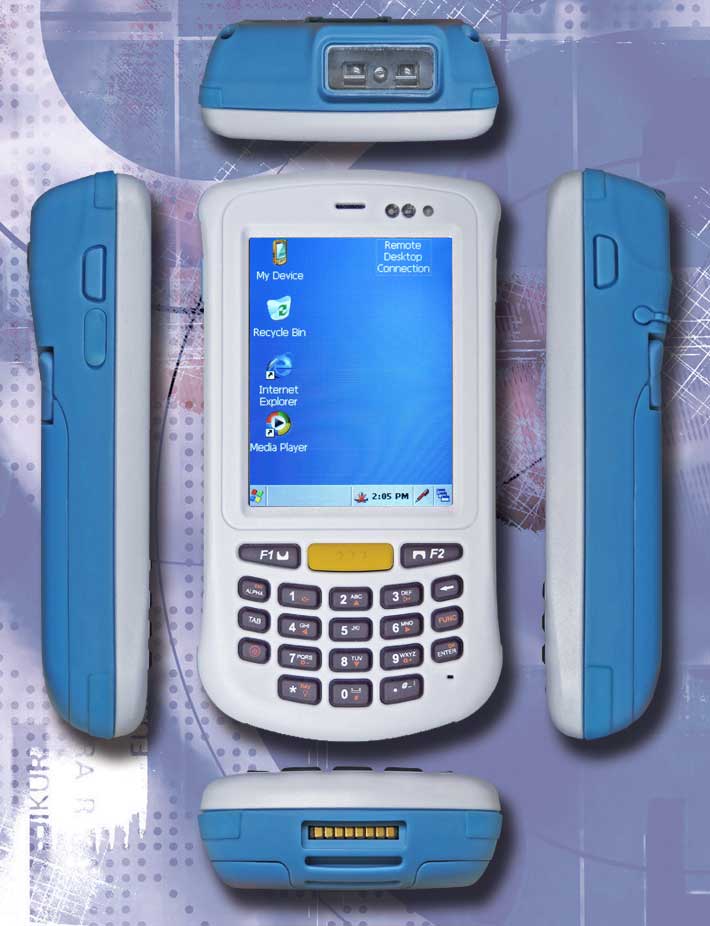
For controls and ports, the C350 is minimalist. On the left and right side are identical scan trigger keys. On the right side you can also see the garage for the handheld's little metal stylus that telescopes out to 3.5 inches. On the left side is a small protective flap to secure the sole port, a micro-USB OTG connector. On the bottom is a surface-mount docking connector for use with the optional cradle. On top is the window for the integrated barcode scanner.
On the face of the C350 is the multi-function keypad that also included large phone keys and yet another scan button (the big yellow one). Above the display is a little speaker for when the device is used as a phone, and next to it the little lenses for the ambient light and proximity sensors.
No card or expansion slots are visible. That's because the unit's micro-SD and SIM card (if so equipped) slots are inside the unit underneath the battery and not externally accessible.
A look inside
While most users of devices such as the Winmate C350 Series will never open them, IT and service departments will usually want to know what's inside, how well a device is made, and whether a device is user-serviceable. That's becoming more and more of an issue in an era where millions of smartphones cannot be opened or serviced at all anymore. Well, the C350 doesn't have that problem. To get to the replaceable battery, all you need to do is open a couple of levers. That also gets you access to the micro-SD card slot beneath the battery and the optional SIM card slot. And to open the entire unit, all you do is undo six little Philips screws. The picture below shows the bottom of the C350 handheld (left) and the bottom with the battery and battery cover removed (right).
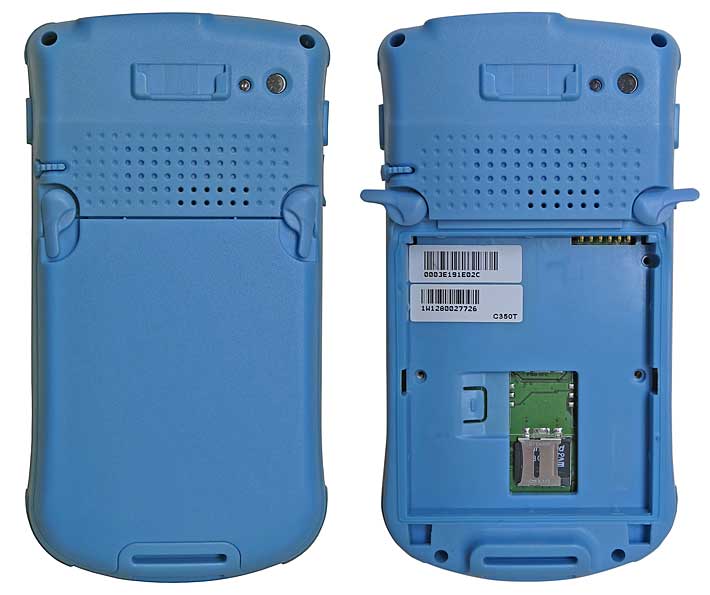
The housing of the C350 consists of two plastic halves, in our healthcare version a light-blue bottom and a white top. The sealing between the two halves uses a tongue-and-grove design with a rubber o-ring sitting in the groove around the perimeter of the bottom part of the housing. There are no twists and turns here where the rubber seal could get twisted or damaged.
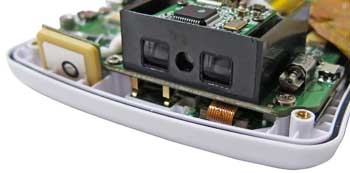 The inside of the C350 is quite basic. Unlike the complex frame and cowlings of the Winmate E430T that we recently reviewed in our lab, the C350 doesn't have a metal subframe or anything of that nature; its motherboard, which fills the entire inside of the unit, is simply mounted onto the topside of the housing. And unlike some state-of-the-art smartphones and tablets with their hyper-integrated tiny motherboards, the 350's looks more like a PC board with its individual components, and all connectors and modules are separate and visible. The inside of the C350 is quite basic. Unlike the complex frame and cowlings of the Winmate E430T that we recently reviewed in our lab, the C350 doesn't have a metal subframe or anything of that nature; its motherboard, which fills the entire inside of the unit, is simply mounted onto the topside of the housing. And unlike some state-of-the-art smartphones and tablets with their hyper-integrated tiny motherboards, the 350's looks more like a PC board with its individual components, and all connectors and modules are separate and visible.
The picture to the right shows the C350's scanner module. Unlike consumer smartphones that may be able to scan using their integrated cameras, professional quality devices such as the C350 use industrial-grade scanners. Depending on the intended use, Winmate offers an inexpensive IR 1D scanner for indoor use, an indoor/outdoor 1D long-range laser scanner, or a 1D/2D CMOS imager with extended symbology support.
The micro-SD card slot (shown below center left) isn't as much a slot as it is a tray where you must slide the cover to one side so that it pivots open, revealing the card underneath. The whole mechanism is quite delicate and since it is not immediately obvious how it works, there's a bit of a danger for inadvertent damage. In devices equipped with the optional 5-megapixel camera, the camera module would sit below the scanner module.
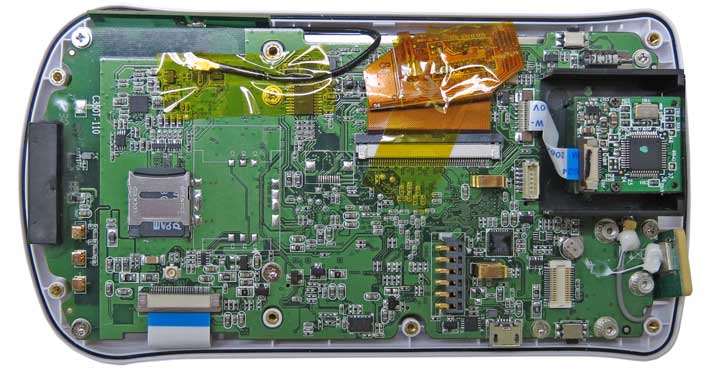
The specs do not provide a lot of detailed information on the device's components. There's a u-blox GPS module, but we're not sure which one. WiFi is single-band 801.11b/g/n, and Bluetooth v2.1 + EDR. And note that users can either specify an optional RFID reader or an optional camera, but not both.
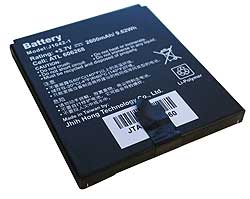 Of interest to IT shops, system integrators and software developers: Winmate offers a barcode and RFID SDK for the C350. Of interest to IT shops, system integrators and software developers: Winmate offers a barcode and RFID SDK for the C350.
The battery (shown in the picture to the right) is a rechargeable Li-Ion 3.7Volt/2,600 mAH Li-Poly 9.6 watt-hours. It's the same slender package also used in the Winmate E430T. The company claims it's good for up to six hours. For some reason, that's almost three hours less than what Winmate claims for the more complex Android-based E430T. A minor concern: the battery compartment is open to the interior of the unit (through the card slot openings), and sealing to the outside is provided solely by the battery compartment door which has a very thin integrated plastic lip, but does not have a replaceable seal.
Overall, everything looked simple and workmanlike inside. This is a cost-efficient design that is easy to customize, work on, and service.
Choice of processor
For almost a decade, Intel/Marvell XScale PXA processors ruled the mobile CPU roost and were found in virtually every PDA and industrial handheld. Those days are gone now, and Winmate, 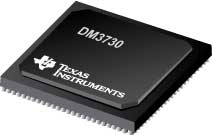 like most others, chose to go with a competing design, in this instance a 1GHz Texas Instruments Cortex A8 DM3730. This chip (where the "DM" stands for Digital Media) is also found in other contemporary rugged handhelds such as the Trimble Juno T41, Motorola's revolutionary HC1 headset computer, and Winmate's own E430T. like most others, chose to go with a competing design, in this instance a 1GHz Texas Instruments Cortex A8 DM3730. This chip (where the "DM" stands for Digital Media) is also found in other contemporary rugged handhelds such as the Trimble Juno T41, Motorola's revolutionary HC1 headset computer, and Winmate's own E430T.
The TI DM3730 processor is actually a multi core system that contains both an ARM Cortex-A8 core and a MEON SIMD co-processor as well as a PowerVR SGX graphics accelerator chip. The chip uses 45nm process technology, was designed by TI to deliver excellent ARM as well as graphics performance at very low power consumption, and it's fully compatible with the OMAP 3 architecture.
Operating System
Interestingly enough, the Winmate C350 Series' default OS is actually Android 2.3.4, but Windows CE 6.0 is optionally available (and was installed on our tester), and Winmate literature even shows Windows Mobile as well. This warrants some discussion.
 The fact, of course, is that the C350 is designed in traditional industrial handheld style, with a physical numeric keypad for rapid data entry and a resistive touch screen. And its display uses the 240 x 320 pixel QVGA resolution that was considered adequate on Pocket PCs and industrial Windows CE devices for many years. It's definitely not a natural for Android as that OS was designed for higher resolution and projected capacitive multi-touch. That said, Winmate has always believed in offering customers choices, and making this cost-effective compact PDA platform available with essentially three different operating systems certainly provides plenty of choice for application developers. The fact, of course, is that the C350 is designed in traditional industrial handheld style, with a physical numeric keypad for rapid data entry and a resistive touch screen. And its display uses the 240 x 320 pixel QVGA resolution that was considered adequate on Pocket PCs and industrial Windows CE devices for many years. It's definitely not a natural for Android as that OS was designed for higher resolution and projected capacitive multi-touch. That said, Winmate has always believed in offering customers choices, and making this cost-effective compact PDA platform available with essentially three different operating systems certainly provides plenty of choice for application developers.
Note that Windows CE (also now known as Windows Embedded CE) and Windows Mobile are the final implementations of Microsoft's legacy mini OS before the company began experimenting with more contemporary and more smartphone-oriented OS software. Of the two Microsoft offerings, Windows Mobile is friendlier, more end-user oriented, and with a number of general apps, whereas Windows CE is more for projects where the devices will primarily run custom-developed software. Compared to both iOS and Android, and even Microsoft's own Windows Phone 7/7.5 and Phone 8, Windows CE looks crude and dated but it could be argued that for many applications, there's still nothing else that provides full and totally reliable interoperability with existing Microsoft enterprise infrastructure while enabling the use of the ubiquitous Microsoft development tools scores of programmers are familiar with.
The overarching fact is that ever since the introduction of Apple's iOS and then Android, user expectations for smartphones, tablets, and handheld computers have fundamentally changed. Before the iPhone, mobile operating systems generally looked and felt like drastically downsized versions of desktop operating systems. The iPhone showed that handheld operating systems can be sleek, fast, elegant and simple to use on displays using projected capacitive technology that allows the softest touch as well as multi-finger operation for zooming, panning, etc.
That's why for now Android is the default OS for this compact Winmate PDA. Android has its own challenges (such as version fragmentation, incompatibilities due to the very large variety of hardware Android runs on, and lack of truly centralized platform control as is the case with iOS), the large and growing number of Android users and Android developers means easy access to programming tools and expertise and a vast number of inexpensive downloadable apps in numerous categories and for numerous applications.
The bottomline here is that a voice and data-capable data collection device that can be used as a PDA as well as a phone, having all those OS choices available, on top of the many hardware options, certainly makes the platform as flexible as any basic handheld can be.
Display and usability
Notebook, tablet and smartphone displays have improved dramatically over the past several years, but by and large, industrial handheld displays have been slow in following suit, and that includes the one used in the C350. 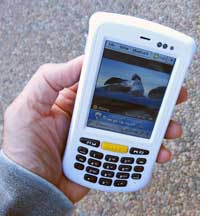 Anyone used to retina-class smartphone displays will be disappointed with just 240 x 320 pixel resolution, color shifts when viewed from an angle, and the reflections inherent in resistive touch screens. But then again, the C350 is not a snazzy smartphone, it's a tool for jobs. Anyone used to retina-class smartphone displays will be disappointed with just 240 x 320 pixel resolution, color shifts when viewed from an angle, and the reflections inherent in resistive touch screens. But then again, the C350 is not a snazzy smartphone, it's a tool for jobs.
Nominally, the C350's display is transflective, which means it has both transmissive (good for indoor viewing) and reflective (good for outdoor viewing) qualities. Unlike purely reflective outdoor LCDs that required an annoying sidelight for indoor use, transflective screens have backlighting that evenly illuminates the display. However, transflective LCD technology doesn't let all the light through, and so even though the C350 is rated at 440 nits (a standard notebook has about 200), the display isn't exceptionally bright.
The picture to the left is an unretouched shot of the unit being used outdoors in broad daylight, with the screen angled to avoid reflections.
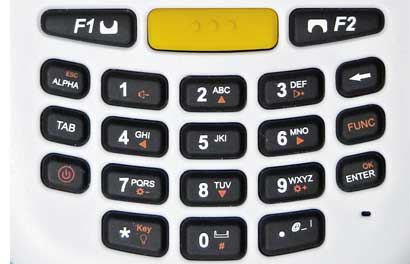 Among the features appealing to those who'll use this device for field data collection is the physical keypad. Onscreen keyboards and keypads have become the norm, but for many applications nothing can replace a good physical keypad, and the C350 has one. It is very solid, the keys are large enough, they don't rattle, and they provide a tactile click feedback when successfully depressed. The keys also have a backlight that can be turned out for use in the dusk or dark. The alpha and secondary functions add brightness and sound control as well as navigation keys. The only problem here is that the orange secondary function icons are tiny and hard to read. Among the features appealing to those who'll use this device for field data collection is the physical keypad. Onscreen keyboards and keypads have become the norm, but for many applications nothing can replace a good physical keypad, and the C350 has one. It is very solid, the keys are large enough, they don't rattle, and they provide a tactile click feedback when successfully depressed. The keys also have a backlight that can be turned out for use in the dusk or dark. The alpha and secondary functions add brightness and sound control as well as navigation keys. The only problem here is that the orange secondary function icons are tiny and hard to read.
We did not run into any meaningful problems with the C350. It wasn't loaded with enough software for us to get a good idea of day-to-day performance. Video on the included Windows Media 9 Series player ran slowly, but that's likely due to the software and not the TI processor that has plenty enough punch to drive the handheld. We were not fans of the unit's deeply recessed micro-USB connector for data exchange with PCs — micro-USB is just a bit too flimsy for industrial field use.
Ruggedness
Like several of Winmate's products, it's not easy to categorize the C350. Winmate's own documentation describes it both as a "compact-class PDA" but also as a "rugged industrial PDA." While those two descriptions conjure up different images — and while our white/light-blue model looked like it'd be perfectly at home in a clinical setting whereas the dark-gray version looked very industrial — the C350 can really be both.
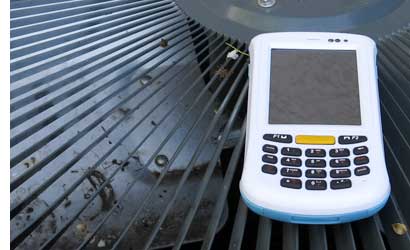 As far as environmental specs go, the device is sealed to IP54 specifications. The first "5" means the device is protected against dust, but with limited (i.e. not harmful) ingress permitted. The second "4" means it is also protected against water sprayed from all directions, again with limited ingress permitted. We interpret that as meaning the C350 can handle a bit of dust and rain but it shouldn't be used in a desert or on a boat. As far as environmental specs go, the device is sealed to IP54 specifications. The first "5" means the device is protected against dust, but with limited (i.e. not harmful) ingress permitted. The second "4" means it is also protected against water sprayed from all directions, again with limited ingress permitted. We interpret that as meaning the C350 can handle a bit of dust and rain but it shouldn't be used in a desert or on a boat.
Winmate's spec sheet lists a wide operating temperature of 14 to 122 degrees Fahrenheit (-10 to 50 Celsius). That means the unit can be used in most operating environment, albeit not commercial freezers (note that Winmate's webpage lists the operating temperature range as a wider -20 to 60 degrees Celsius).
The device carries a 4-foot drop spec, which means it'll easily survive being dropped on the ground while being carried around. Winmate also performed a "tumble" test which sort of mimics it being dropped out of a pocket while walking, or falling off a moving cart. Overall, the C350 feels sturdy and trust-inspiring. It's not likely that it'll physically break on the job.
Bottom line: Winmate C350T industrial/compact PDA
At first sight the Winmate C350T looks like a throwback to the earlier era of Pocket PCs, the pre-iPhone time when PDAs had not yet evolved into super-slender glass and metal minislates. But that's misleading because it's really an intelligently designed device that values function over form. The large physical keypad allows for rapid data entry in the field, the tough industrial plastic case and recessed display offer excellent protection, the device can run either a legacy mobile OS or the ever more popular Android platform, and it can also be used as a phone.
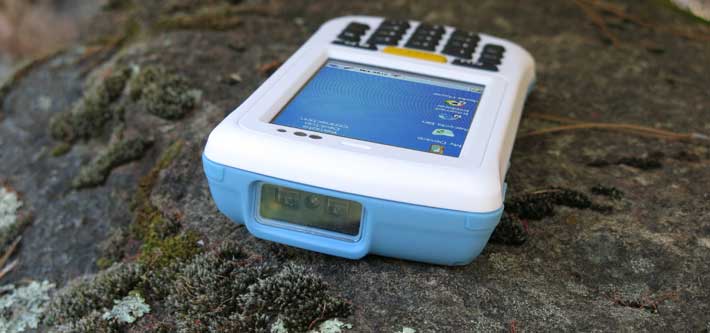
While the 3.5-inch 240 x 320 pixel resistive touch screen looks and feels quaint to those used to modern smartphones, it's perfectly suitable for numerous jobs. Depending on the intended use, industrial-grade 1D or 1D/2D scanners, RFID, 3.5G WWAN and GPS are all available. And the electronic underpinnings are all up-to-date. Add to that your choice of Android or Windows CE/Mobile and you have a very flexible handheld computing platform suitable for numerous industries and applications. There's definitely room for such a device.
-- Conrad H. Blickenstorfer, March 2013
|
Winmate C350T Specifications
|
| Added/changed |
Added 10/2012, full review 03/2013
|
| Type |
Compact industrial PDA
|
| Processor |
1GHz Texas Instruments DM3730 with DSP |
| OS |
Android 2.3.5, Windows CE 6.0 or Windows Mobile 6.5.3 |
| RAM/ROM |
256MB/512MB NAND FLASH |
| Display |
3.5" color transflective TFT with QVGA (240 x 480 pixel) resolution (440 nits) |
| Digitizer/Pens |
4-wire resistive touch |
| Keyboard/keys |
23-key alphanumeric with backlight |
| Navigation |
touch/stylus/keypad |
| Expansion slots |
1 1 micro-SD card, 1 SIM (both internal) |
| Housing |
ABS plastic with rubberized bumper areas |
| Size |
3.1 x 6.0 x 1.14 inches (78 x 153 x 29 mm) |
| Weight |
9.9 ounces (280 grams) with battery |
| Temperature |
14° to °122 degrees Fahrenheit (-10° to 50°C) |
| Ingress Protection |
IP54 (protected against dust-proof and low pressure water spray from all directions, limited ingress permitted) |
| Drop |
4 feet to concrete |
| Tumbling |
150 1.65 ft./0.5 m tumbles (equivalent to 300 consecutive drops) |
| Humidity |
10-95% RH (non condensing) |
| ESD |
NA |
| Regulatory |
CE, FCC class B |
| Power |
Rechargeable Li-Polymer 3.7Volt/2,600 mAH 9.6 watt-hour ("up to 6 hours") |
| Camera |
Optional 5-megapixel (front, alternative to RFID |
| Sensors |
Proximity and ambient light |
| Communication |
802.11b/g/n WiFi, Class 2 Bluetooth v2.1 + EDR, GPS (<2.5m autonomous, <2.0m SBAS); optional RFID, 3G WWAN module (WCDMA, HSDPA, HSUPA, GPRS850/900/1800/1900, EDGE850/900/1800/1900) |
| Interface |
1 x micro-USB OTG host and client, surface-mount docking |
Price |
inquire |
| Webpage |
Winmate C350 product page |
| Contact |
Sales1@winmate.com
Winmate Inc.
9F, No. 111-6, Shing-De Road,
San-Chung City,
Taipei, Taiwan 241, R.O.C.
Fax: +886-2-8511-0211
Web: www.winmate.com |
|
|



